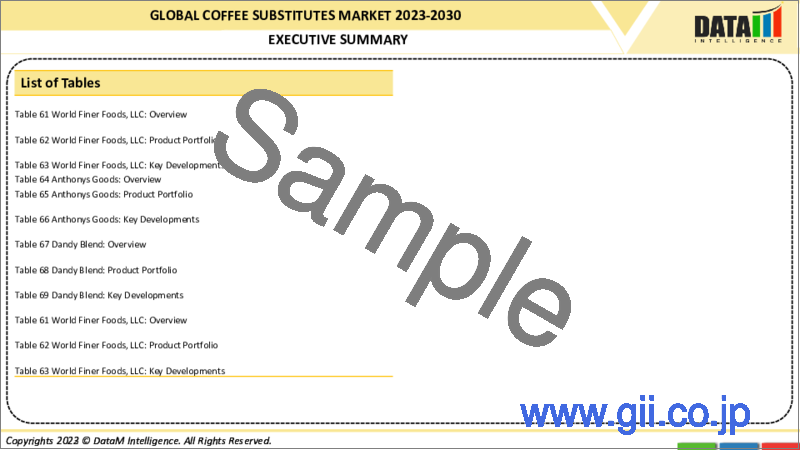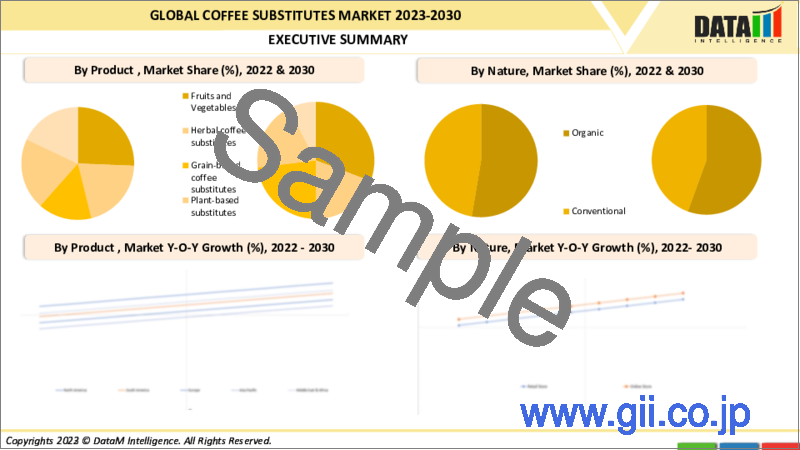|
|
市場調査レポート
商品コード
1316244
代用コーヒーの世界市場:2023年~2030年Global Coffee Substitutes Market - 2023-2030 |
||||||
カスタマイズ可能
適宜更新あり
|
|||||||
| 代用コーヒーの世界市場:2023年~2030年 |
|
出版日: 2023年07月27日
発行: DataM Intelligence
ページ情報: 英文 200 Pages
納期: 即日から翌営業日
|
- 全表示
- 概要
- 目次
市場概要
世界の代用コーヒー市場は、2022年に27億米ドルに達し、2030年には53億米ドルに達するという有利な成長が予測されています。予測期間中のCAGRは8.9%です。
代用コーヒーとは、コーヒーが入手できない場合やカフェインの摂取量を減らしたい場合に、コーヒーの代わりとして使用される飲料です。これらの飲料は様々な材料から作られ、コーヒーとは異なる風味特徴と刺激レベルを提供します。カモミール、ペパーミント、ジンジャーなどのハーブティーはノンカフェインで、気持ちを落ち着かせる効果があります。カフェインを完全に避けたい人には良い選択肢です。
代用コーヒーメーカー各社は、特定の嗜好や食生活の嗜好に合わせたスペシャルティブレンドを製造しています。これらのブレンドは、焙煎した穀物、チコリ根、その他の材料を組み合わせて、ユニークな風味体験を提供し、より幅広い消費者層にアピールしています。Healthlineによると、米国では成人の85%以上がカフェインを定期的に摂取しており、1日の平均摂取量は180mgです。
市場力学
文化の変化とパーソナルケア分野におけるカフェイン代替品へのニーズの高まり
多くの人々が健康志向を強め、カフェインによるイライラ、睡眠障害、中毒などの潜在的な悪影響に対する懸念から、従来の代用コーヒーを求めるようになっています。このような消費者行動の変化により、消費者は、同様の風味と経験を提供し、欠点のない代用コーヒーを探求するようになっています。
菜食主義、ベジタリアン、その他特定の食事制限を含む食事パターンの変化が、代用コーヒーの需要拡大に寄与しています。多くの代用コーヒーは植物由来であり、こうした生活様式や食事制限に従う人々に適しています。その結果、パーソナルケア業界は、こうした消費者の多様なニーズに応えるため、幅広い種類の代用コーヒーを提供することで対応しています。
カフェインが健康に及ぼす悪影響に対する意識の高まりは、代用コーヒー市場の成長にとって大きなチャンスです
カフェインが健康に及ぼす悪影響に対する意識の高まりは、代用コーヒー市場に大きなチャンスをもたらす可能性があります。コーヒーは人気のある飲料だが、カフェインを含んでおり、不安、不眠、高血圧など、個人によっては悪影響を及ぼす可能性があります。こうした潜在的な健康リスクに対する認識が高まるにつれ、人々は、悪影響のない、似たような風味を提供する代用コーヒーを求めるようになるかもしれないです。
ハーブティー、チコリルート、焙煎大麦などの代用コーヒーは、健康志向の消費者にアピールできるノンカフェインの代用コーヒーを提供します。これらの製品は、コーヒー愛好家の味覚を満足させながら、より健康的な選択肢を提供できるユニークな風味を備えています。例えば、ヘルスラインによると、コーヒーは緑茶の3倍以上のカフェインを含んでいます。8オンス(240mL)のコーヒーには96mgのカフェインが含まれているが、同じ量の緑茶には29mgのカフェインが含まれています。代用コーヒーは、従来のコーヒーに代わる健康的な代用品として位置づけられ、この成長市場を開拓することができます。
代用コーヒーの認知度の低さが代用コーヒー市場成長の課題
代用コーヒーの認知度が低いことは、代用コーヒー市場の成長にとって課題となりうる。多くの消費者は代用コーヒーに馴染みがなく、その利点を理解していない可能性があります。さらに、特にコーヒーを飲み慣れ、その味と効果に満足している消費者の中には、新しい製品を試すことをためらう人もいるかもしれません。もう一つの課題は、代用コーヒーはコーヒーよりも劣る、あるいは楽しみが少ないという認識です。
コーヒーは文化的・社会的な結びつきが強いため、消費者がコーヒーより劣ると感じる代用品に置き換えることは難しいかもしれないです。このような課題を克服するために、代用コーヒーメーカーは、消費者が代用コーヒーの利点を理解できるような教育や啓発活動に注力することができます。また、マーケティングやブランディングに投資して、自社製品を高品質で楽しい代用コーヒーとして位置づけることもできます。
COVIDの影響
COVID-19の大流行はeコマースとオンライン小売の成長を加速させました。実店舗の閉鎖や社会的距離の縮小に伴い、消費者は好みの製品を購入するためにオンライン・プラットフォームを利用するようになっています。強力なオンライン・プレゼンスと効率的な消費者直販チャネルを持つ代用コーヒーブランドは、この消費者行動の変化から利益を得たと思われます。パンデミックは、様々な原材料の調達や輸送を含む世界なサプライチェーンに混乱をもたらしました。代用コーヒーメーカーは、特定の原材料の調達に課題を抱えたり、生産や流通の遅れに直面した可能性があります。こうしたサプライチェーンの混乱は、代用コーヒーの入手可能性や市場力学に影響を与えた可能性があります。
ロシア・ウクライナ戦争の影響:
ロシア・ウクライナ戦争のような地政学的紛争は、世界のサプライチェーンを混乱させる可能性があります。代用コーヒーが紛争の影響を受けた地域から調達した原料に依存していたり、輸送ルートが寸断されていたりすると、これらの製品の入手や流通に課題が生じる可能性があります。その結果、供給不足や供給遅延が生じ、代用コーヒー市場に影響を及ぼす可能性があります。
地政学的な緊張は、しばしば関係国間の貿易制限、関税、禁輸措置の発動につながります。ロシアとウクライナの紛争がこのような措置につながれば、代用コーヒーや関連原料の輸出入に影響を及ぼす可能性があります。関税や貿易障壁によるコスト上昇は、価格設定や市場力学に影響を与える可能性があります。
目次
第1章 調査手法と調査範囲
第2章 定義と概要
第3章 エグゼクティブサマリー
第4章 市場力学
- 影響要因
- 促進要因
- 抑制要因
- 機会
- 影響分析
第5章 産業分析
- ポーターのファイブフォース分析
- サプライチェーン分析
- 価格分析
- 規制分析
第6章 COVID-19分析
第7章 性質別
- オーガニック
- 従来品
第8章 包装別
- パウチ
- 無菌カートン
- 缶詰
第9章 流通チャネル別
- スーパーマーケット・ハイパーマーケット
- 専門店
- オンライン販売
- その他
第10章 地域別
- 北米
- 米国
- カナダ
- メキシコ
- 欧州
- ドイツ
- 英国
- フランス
- イタリア
- スペイン
- その他欧州
- 南米
- ブラジル
- アルゼンチン
- その他南米
- アジア太平洋
- 中国
- インド
- 日本
- オーストラリア
- その他アジア太平洋地域
- 中東・アフリカ
第11章 競合情勢
- 競合シナリオ
- 市況/シェア分析
- M&A分析
第12章 企業プロファイル
- Postum
- 会社概要
- 製品ポートフォリオと説明
- 財務概要
- 主な発展
- Rishi Tea and Botanicals
- Mondelez International Inc.
- Teeccino Caffe Inc.
- World Match Inc.
- drink NUJO
- Anthony Goods
- So Good Brand Inc.
- Dandy Blend
- The Hain Celestial Group Inc.
第13章 付録
Market Overview
Global Coffee Substitutes Market reached US$ 2.7 billion in 2022 and is projected to witness lucrative growth by reaching up to US$ 5.3 billion by 2030. The market is growing at a CAGR of 8.9% during the forecast period.
Coffee substitutes are beverages that are used as a replacement for coffee, either because coffee is not available or because the person wants to reduce their caffeine intake. These beverages are made from various ingredients and offer a different flavor profile and level of stimulation compared to coffee. Herbal teas, such as chamomile, peppermint, or ginger, are caffeine-free and can offer a calming effect. They are a good option for those who want to avoid caffeine altogether.
Coffee substitute manufacturers are creating specialty blends that cater to specific tastes and dietary preferences. These blends may combine roasted grains, chicory root, and other ingredients to offer a unique flavor experience and appeal to a broader consumer base. According to Healthline, in the United States, more than 85% of adults consume caffeine regularly, with an average daily intake of 180 mg, which is the amount of caffeine in about 2 cups of coffee.
Market Dynamics
A Changing Culture and Rising Need for Caffeine Alternatives in the Personal Care Sector
Many individuals are becoming more health-conscious and seeking alternatives to traditional coffee due to concerns about its potential adverse effects, such as caffeine-induced jitters, sleep disturbances, and addiction. This shift in consumer behavior has prompted them to explore coffee substitutes that offer a similar flavor and experience but without drawbacks.
Changing dietary patterns, including veganism, vegetarianism, and other specific dietary restrictions, have contributed to the growing demand for coffee substitutes. Many coffee substitutes are plant-based and suitable for individuals following these lifestyle choices or dietary requirements. As a result, the personal care industry has responded by offering a wide range of coffee alternatives to cater to these diverse consumer needs.
Rising Awareness of the Harmful Effects of Caffeine on Health is a Great Opportunity for the Coffee Substitute Market to Grow
The rising awareness of the harmful effects of caffeine on health can create a significant opportunity for the coffee substitute market. While coffee is a popular beverage, it contains caffeine, which can have negative effects on some individuals, including anxiety, insomnia, and high blood pressure. As people become more aware of these potential health risks, they may seek out alternatives to coffee that offer similar flavor profiles without negative side effects.
Coffee substitutes, such as herbal teas, chicory root, and roasted barley, provide a caffeine-free alternative to coffee that can appeal to health-conscious consumers. These products offer a unique flavor profile that can satisfy the taste buds of coffee lovers while providing a healthier option. For instance, according to Healthline, coffee provides more than three times the amount of caffeine than green tea. An 8-ounce (240 mL) serving of coffee provides 96 mg of caffeine, while the same amount of green tea provides 29 mg. Coffee substitutes can position themselves as a healthier alternative to traditional coffee and tap into this growing market.
Limited Awareness of the Coffee Substitutes to Challenge the Coffee Substitute Market Growth
The limited awareness of coffee substitutes can be a challenge to the growth of the coffee substitute market. Many consumers may not be familiar with coffee substitutes and may not understand their benefits, which could result in lower demand for these products. Additionally, some consumers may be hesitant to try new products, especially if they are used to drinking coffee and are satisfied with its taste and effects. Another challenge is the perception of coffee substitutes as inferior or less enjoyable than coffee.
Coffee has a strong cultural and social association, and it may be difficult for consumers to replace this beverage with a substitute that they perceive as less desirable. To overcome these challenges, coffee substitute companies can focus on education and awareness-building efforts to help consumers understand the benefits of coffee substitutes. They can also invest in marketing and branding efforts to position their products as a high-quality and enjoyable alternative to coffee.
COVID Impact:
The COVID-19 pandemic accelerated the growth of e-commerce and online retail. With physical store closures and social distancing measures, consumers increasingly turned to online platforms to purchase their preferred products. Coffee substitute brands that have a strong online presence and efficient direct-to-consumer channels have likely benefited from this shift in consumer behavior. The pandemic caused disruptions in global supply chains, including the sourcing and transportation of various ingredients. Coffee substitute manufacturers might have experienced challenges in procuring specific ingredients or faced delays in production and distribution. These supply chain disruptions could have impacted the availability and market dynamics of coffee substitutes.
Russia-Ukraine War Impact:
Geopolitical conflicts, such as the Russia-Ukraine war, can disrupt global supply chains. If coffee substitutes rely on ingredients sourced from regions affected by the conflict or if transportation routes are disrupted, it can lead to challenges in the availability and distribution of these products. This, in turn, may impact the coffee substitute market by causing shortages or delays in supply.
Geopolitical tensions often result in the imposition of trade restrictions, tariffs, or embargoes between the involved countries. If the Russia-Ukraine conflict leads to such measures, it could affect the import and export of coffee substitutes and related ingredients. Higher costs due to tariffs or trade barriers may impact pricing and market dynamics.
Segment Analysis
The global coffee substitutes market is segmented based on nature, packaging, distribution channel, and region.
Based on Packaging, the Pouches and Sachets Segment Holds the Highest Market Share
The pouches and sachets segment is expected to hold the largest market share in the coffee substitute market for several reasons. The convenience factor is a significant driver of growth in this segment. Pouches and sachets are easy to use and can be carried around easily, making them ideal for on-the-go consumption. This convenience factor is especially appealing to busy consumers who are looking for a quick and hassle-free option.
Moreover, the pre-measured nature of pouches and sachets can make them more attractive to consumers who are new to coffee substitutes. These consumers may not be familiar with the taste and preparation process of coffee substitutes and may be hesitant to purchase larger quantities. Pouches and sachets provide a low-risk option for consumers to try new products without committing to a large purchase.
Geographical Analysis
Asia Pacific is the Fastest-Growing Market Due to the Major Consumer Adoption
Asia Pacific is a highly populated region, and coffee substitutes are popular in countries with large populations like India, China, and Indonesia. These countries have a long history of using herbal and plant-based ingredients in traditional medicine, and many consumers in these countries are already familiar with the health benefits of coffee substitutes. According to Cargill's report, The ready to drink (RTD) tea is fast growing segment in the beverage category. Sales are expected to reach USD 84 billion by 2024.
Consumers are becoming more health-conscious and are looking for alternatives to coffee that offer health benefits. Furthermore, the growing middle class in the Asia Pacific is also driving the growth of the coffee substitute market. As disposable income increases, consumers in the region are looking for new and innovative products, and coffee substitutes are increasingly becoming a part of their diet.
Competitive Landscape
The major global players include: Postum, Teeccino Caffee Inc., Rishi Tea and Botanicals, World Match Inc., drink NUJO, Anthony Goods, So Good Brand Inc., Dandy Blend, The Hain Celestial Group Inc., and Mondelez International Inc.
Why Purchase the Report?
- To visualize the global coffee substitutes market segmentation based on nature, packaging, and distribution channel understand key commercial assets and players.
- Identify commercial opportunities by analyzing trends and co-development.
- Excel data sheet with numerous data points of coffee substitutes market-level with all segments.
- PDF report consists of a comprehensive analysis after exhaustive qualitative interviews and an in-depth study.
- Product mapping available as Excel consisting of key products of all the major players.
The global coffee substitutes market report would provide approximately 61 tables, 57 figures, and 200 Pages.
Target Audience 2023
- Manufacturers/ Buyers
- Industry Investors/Investment Bankers
- Research Professionals
- Emerging Companies
Table of Contents
1. Methodology and Scope
- 1.1. Research Methodology
- 1.2. Research Objective and Scope of the Report
2. Definition and Overview
3. Executive Summary
- 3.1. Snippet by Nature
- 3.2. Snippet by Packaging
- 3.3. Snippet by Distribution Channel
- 3.4. Snippet by Region
4. Dynamics
- 4.1. Impacting Factors
- 4.1.1. Drivers
- 4.1.2. Restraints
- 4.1.3. Opportunity
- 4.1.4. Impact Analysis
5. Industry Analysis
- 5.1. Porter's Five Force Analysis
- 5.2. Supply Chain Analysis
- 5.3. Pricing Analysis
- 5.4. Regulatory Analysis
6. COVID-19 Analysis
- 6.1. Analysis of COVID-19
- 6.1.1. Scenario Before COVID
- 6.1.2. Scenario During COVID
- 6.1.3. Scenario Post COVID
- 6.2. Pricing Dynamics Amid COVID-19
- 6.3. Demand-Supply Spectrum
- 6.4. Government Initiatives Related to the Market During Pandemic
- 6.5. Manufacturers Strategic Initiatives
- 6.6. Conclusion
7. By Nature
- 7.1. Introduction
- 7.1.1. Market Size Analysis and Y-o-Y Growth Analysis (%), By Nature
- 7.1.2. Market Attractiveness Index, By Nature
- 7.2. Organic*
- 7.2.1. Introduction
- 7.2.2. Market Size Analysis and Y-o-Y Growth Analysis (%)
- 7.3. Conventional
8. By Packaging
- 8.1. Introduction
- 8.1.1. Market Size Analysis and Y-o-Y Growth Analysis (%), By Packaging
- 8.1.2. Market Attractiveness Index, By Packaging
- 8.2. Pouches*
- 8.2.1. Introduction
- 8.2.2. Market Size Analysis and Y-o-Y Growth Analysis (%)
- 8.3. Aseptic Cartons
- 8.4. Cans
9. By Distribution Channel
- 9.1. Introduction
- 9.1.1. Market Size Analysis and Y-o-Y Growth Analysis (%), By Distribution Channel
- 9.1.2. Market Attractiveness Index, By Distribution Channel
- 9.2. Supermarkets/Hypermarkets*
- 9.2.1. Introduction
- 9.2.2. Market Size Analysis and Y-o-Y Growth Analysis (%)
- 9.3. Specialty Stores
- 9.4. Online Sales
- 9.5. Others
10. By Region
- 10.1. Introduction
- 10.1.1. Market Size Analysis and Y-o-Y Growth Analysis (%), By Region
- 10.1.2. Market Attractiveness Index, By Region
- 10.2. North America
- 10.2.1. Introduction
- 10.2.2. Key Region-Specific Dynamics
- 10.2.3. Market Size Analysis and Y-o-Y Growth Analysis (%), By Nature
- 10.2.4. Market Size Analysis and Y-o-Y Growth Analysis (%), By Packaging
- 10.2.5. Market Size Analysis and Y-o-Y Growth Analysis (%), By Distribution Channel
- 10.2.6. Market Size Analysis and Y-o-Y Growth Analysis (%), By Country
- 10.2.6.1. The U.S.
- 10.2.6.2. Canada
- 10.2.6.3. Mexico
- 10.3. Europe
- 10.3.1. Introduction
- 10.3.2. Key Region-Specific Dynamics
- 10.3.3. Market Size Analysis and Y-o-Y Growth Analysis (%), By Nature
- 10.3.4. Market Size Analysis and Y-o-Y Growth Analysis (%), By Packaging
- 10.3.5. Market Size Analysis and Y-o-Y Growth Analysis (%), By Distribution Channel
- 10.3.6. Market Size Analysis and Y-o-Y Growth Analysis (%), By Country
- 10.3.6.1. Germany
- 10.3.6.2. The UK
- 10.3.6.3. France
- 10.3.6.4. Italy
- 10.3.6.5. Spain
- 10.3.6.6. Rest of Europe
- 10.4. South America
- 10.4.1. Introduction
- 10.4.2. Key Region-Specific Dynamics
- 10.4.3. Market Size Analysis and Y-o-Y Growth Analysis (%), By Nature
- 10.4.4. Market Size Analysis and Y-o-Y Growth Analysis (%), By Packaging
- 10.4.5. Market Size Analysis and Y-o-Y Growth Analysis (%), By Distribution Channel
- 10.4.6. Market Size Analysis and Y-o-Y Growth Analysis (%), By Country
- 10.4.6.1. Brazil
- 10.4.6.2. Argentina
- 10.4.6.3. Rest of South America
- 10.5. Asia-Pacific
- 10.5.1. Introduction
- 10.5.2. Key Region-Specific Dynamics
- 10.5.3. Market Size Analysis and Y-o-Y Growth Analysis (%), By Nature
- 10.5.4. Market Size Analysis and Y-o-Y Growth Analysis (%), By Packaging
- 10.5.5. Market Size Analysis and Y-o-Y Growth Analysis (%), By Distribution Channel
- 10.5.6. Market Size Analysis and Y-o-Y Growth Analysis (%), By Country
- 10.5.6.1. China
- 10.5.6.2. India
- 10.5.6.3. Japan
- 10.5.6.4. Australia
- 10.5.6.5. Rest of Asia-Pacific
- 10.6. Middle East and Africa
- 10.6.1. Introduction
- 10.6.2. Key Region-Specific Dynamics
- 10.6.3. Market Size Analysis and Y-o-Y Growth Analysis (%), By Nature
- 10.6.4. Market Size Analysis and Y-o-Y Growth Analysis (%), By Packaging
- 10.6.5. Market Size Analysis and Y-o-Y Growth Analysis (%), By Distribution Channel
11. Competitive Landscape
- 11.1. Competitive Scenario
- 11.2. Market Positioning/Share Analysis
- 11.3. Mergers and Acquisitions Analysis
12. Company Profiles
- 12.1. Postum*
- 12.1.1. Company Overview
- 12.1.2. Product Portfolio and Description
- 12.1.3. Financial Overview
- 12.1.4. Key Developments
- 12.2. Rishi Tea and Botanicals
- 12.3. Mondelez International Inc.
- 12.4. Teeccino Caffe Inc.
- 12.5. World Match Inc.
- 12.6. drink NUJO
- 12.7. Anthony Goods
- 12.8. So Good Brand Inc.
- 12.9. Dandy Blend
- 12.10. The Hain Celestial Group Inc.
LIST NOT EXHAUSTIVE
13. Appendix
- 13.1. About Us and Services
- 13.2. Contact Us






